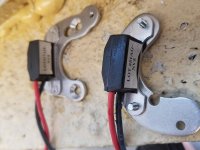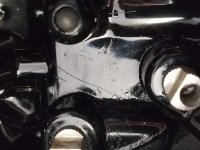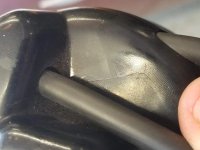Hi Doug, will try this now. Ill first try the way john mentioned above then do what your pointing out and post back in a min...
At the coil, remove the high-tension lead going to the distributor cap.
Remove the spark plug wire and plug for cylinder #1 from the engine and from the dizzy cap.
Plug that wire into the center terminal of the coil, seat the spark plug in the other end of the wire, then rest the plug on the cylinder head. (I prefer this to holding the wire next to the head as suggested above. I've been bitten too many times).
Now have someone crank the engine while you watch for a spark at the plug resting on the head.
If you do see the plug sparking, that says the coil and module are working. That means the problem is in either the rotor, cap, or main high-tension lead lead.
If you do not see a spark there are a few potential problems to check for...
Did you remember to fit the Pertronix magnet ring under the rotor?
With the wires removed does the coil still have about 3 Ohms across its low-tension terminals?
Is there a ground wire present between the breaker plate and the dizzy housing?
BTW, Steve G. and I have been told different values for the Pertronix overheat time. He was told 45 seconds, I was told 3 minutes, others I know have been told 5 minutes. Regardless, it's a known problem. Whenever I need to work on something that requires leaving the ignition on I unplug the Pertronix red wire first.

 Hi Guest!
Hi Guest!

 smilie in place of the real @
smilie in place of the real @
 Pretty Please - add it to our Events forum(s) and add to the calendar! >>
Pretty Please - add it to our Events forum(s) and add to the calendar! >> 





